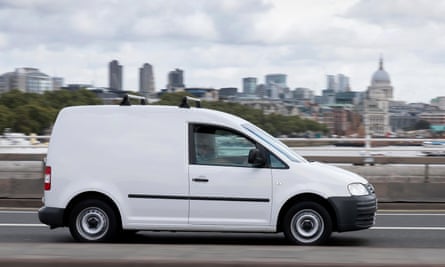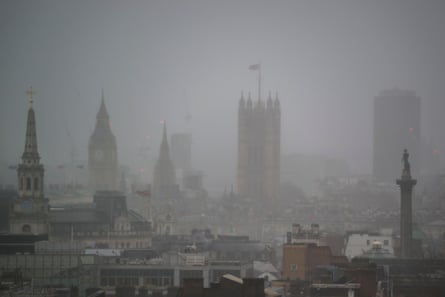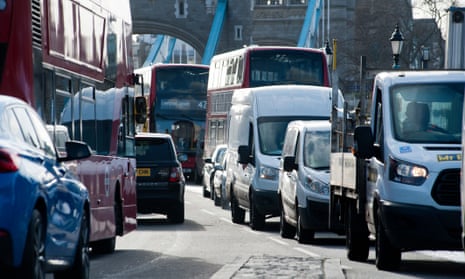High Holborn on a bleak winter morning is a portrait of traffic hell. Vehicles grind east to west through an orange maze of construction and utility works. John Lewis and Argos trucks jostle with Thames Water vehicles; at one point, a flood of white vans appears in sequence, as if a fleet controller had ordered an invasion of the West End of London. Black-cab drivers lean on their steering wheels for support; one holds his head in his hands. The last passenger on a static number 8 bus hovers by the doors, hoping forlornly that the driver will release him into the streets.
In the few visible cars, there are no-smoking stickers that identify them as rides for hire. In the melee, one type of vehicle seems almost completely absent: the private car.
“London has achieved the impossible by eradicating the private car – and still having desperate traffic congestion,” says Prof Tony Travers, the director of LSE London, a research centre at the London School of Economics that explores the city’s economic and social concerns. “People keep saying we need to get the cars off the road. In central London, there aren’t any.”
The idea of blocking cars from urban centres is catching on fast, accelerated by concerns over air pollution and the climate emergency. Brighton is the latest city to propose a zone where private car journeys are banned. Among others, York is considering barring cars within its medieval walls; Bristol will exclude diesel cars from a central area between 7am and 3pm; Birmingham is developing a plan to stop people driving through the city centre; and Cardiff wants to introduce a congestion charge.
London brought in such a fee 17 years ago. “The congestion charge sealed the deal … but traffic wardens, bus lanes and double-yellow lines were a gradual deterrent before that,” says the transport historian Christian Wolmar. In the late 60s and 70s, a young Wolmar would drive his Austin 1100 from Kensington and park off Oxford Street or Pall Mall, to go to John Lewis in the day or the cinema by night; as a child, he would sometimes accompany his father when he drove into town to work near Berkeley Square. “I don’t think I ever saw him on a bus.”

However, Wolmar says the experience was “pretty nightmarish”: “There was no ‘golden age’ when there was no traffic. I could spend half an hour around Marble Arch. The last time I drove into central London was in the 90s, to go to a Chinese restaurant. That culture of being able to drive and park wherever you like no longer exists.”
The number of cars in the City of London fell 15% either side of the introduction in 2003 of the congestion charge – allied since April 2019 with an ultra-low emission zone that more than doubles the daily charge for older diesel cars to £24. The city is also blessed with quicker, cheaper public transport alternatives.
According to Peter Ackroyd’s book London: The Biography, vehicles in the city moved at approximately 12mph in late Victorian times, before mass car ownership, when the streets were “filled with the ceaseless incessant stream of horse-drawn, motor-driven and steam-propelled traffic”. By 2018, the average speed on A roads in the City and Westminster was about 8mph. So why is traffic moving more slowly than ever?
Among most analysts, there is consensus on two underlying reasons: more vans and more Ubers. But in case we should feel righteously smug, Travers adds a list of contributors to the gridlock: “Cycle lanes, in some places, are bad. Ubiquitous four-way pedestrian crossing. Wider pavements. Any one of those makes perfect sense individually. But the buses are completely screwed.”
The bus easily outstrips the tube and rail as the main mode of transport for Londoners – even more so among disabled people, those with mobility problems and the poorest residents. Frozen prices, plus the introduction in 2016 of the hopper fare, which allows unlimited journeys within one hour for the cost of one trip, have made buses even cheaper under the current mayor, Sadiq Khan. However, the network has shrunk and patronage has declined in the past four years.
About a quarter of London buses are run by the Go-Ahead Group. David Brown, its chief executive, says: “London lost a lot of passengers in 2015-16 because the speed of my number 11 bus was 4mph. You could walk faster than that. Increasing congestion is the biggest problem we face. Congestion has such a negative impact. Air quality worsens. The slower buses go, the more people get out of them and get into the car, and the slower it will go. All you get is more traffic idling, belching out fumes.”
Figures from the Department for Transport show that traffic speeds have declined across Britain over the past decade, particularly in urban areas. Recovery from the financial crisis, plus cheap credit deals, has meant more cars on the road.
Brown says it is a problem for buses throughout his operation, from Plymouth to Newcastle and East Anglia to Manchester: “Congestion has increased by 14% across all UK cities. If we’ve got slower speeds, we either accept that the frequency of the bus will be less, or we put more cost in – and fares up. Either way, we lose passengers. For every 10% increase in congestion, there’s a corresponding 10% decrease in passenger numbers.”
Few places in Britain, though, approach the near-inertia of central London – despite its falling car use. Across Greater London – where roughly one in two people own or use a car – private car trips make up only 37% of journeys, compared with 50% in 2003, according to Christina Calderato, the head of transport strategy and planning at Transport for London. “The key context is that the population is growing. London has grown by almost a million people in the past 10 years. All those people, even if they’re not travelling by car, still have to have their homes serviced – and receive deliveries.”
The fastest multiplying element of traffic everywhere is the light commercial vehicle – better known as the delivery van. Van journeys have shot up by 25% in the past decade in Britain, as online shopping has fuelled what Travers calls “the wild west of deliveries”. Even logistics firms, the business of which is fuelled by shoppers, grumble privately about the craziness of Amazon Prime and similar next-day promises: deliveries that could have been efficiently combined are instead expedited, spawning more trips.
Tackling that is a headache, as Brown knows. In a previous job at TfL, he tried to curb the numbers of delivery vehicles coming into London before the Olympics, when fears of gridlock were at their height. “I was looking at Amazon, then I realised there were a hundred and one people delivering to my own building every second. Just trying to get 11 floors and 2,500 people working for TfL to change their behaviour was hard enough.”

Some of these deliveries were personal items; others were the result of various departments ordering their own photocopying paper, which arrived at different floors at different times. TfL had some success consolidating these trips, “but it was really hard yards, down in the detail”. Meanwhile, Brown says, “Regent Street had 36 different operators doing recycling. Each person was doing the right thing, but add them all up together …”
The boom in urban construction – most visibly the spate of skyscrapers in the Square Mile – has also been a factor. “They generate trips,” says Calderato. “There’s a lot of road space needed for the construction traffic.” Adjacent roads can be ripped up to divert utilities, creating more roadworks. Once these buildings are built, the lifts need to be maintained, the offices need to be serviced – and, of course, there will be many deliveries.
If Amazon and co is one villain of congestion, another is Uber and its imitators. After the ride-hailing app reached London in 2013, the number of licensed private-hire vehicles surged, from 49,800 to 87,400 by 2017.
Their numbers far outstrip the 21,000 black cabs in London, but without the dedicated ranks where traditional taxis can stop. The upshot is that many drivers simply circle and wait for customers, creating traffic that doesn’t yet know where it is going. According to Calderato, by early 2019, “about 28% of them were empty”.
Uber says it is committed to reducing individual car ownership and points out it has recently integrated public transport information into its app. Its car-pooling option is used by 350,000 Londoners, which a spokesman said saved 1.7m miles driven last year.
Surprisingly, perhaps, the leader of the black-cab lobby doesn’t primarily blame Uber. Instead, Steve McNamara, the chief executive of the Licensed Taxi Drivers’ Association (and a former student of traffic engineering), says a lack of joined-up planning has brought London roads to a standstill. “There are too many people making too many disjointed decisions. TfL own 5% of the road space and the boroughs own the rest. It’s all about capacity … They’ve narrowed all the roads and taken away road space.”
McNamara points to a junction on the edge of the congestion zone, opposite St Pancras station. “Camden make the decision to close the top of Judd St. As a result of stopping that infinitesimal bit of traffic, the traffic lights can’t cope with the right turn vehicles now have to make. People come two hours whizzing on the Eurostar from Paris and spend 40 minutes waiting to cross the Euston Road in a taxi.”
Traffic is monitored from TfL’s Palestra building in Southwark and controlled, to some extent, through an automated system known as Scoot, which adapts the signals on key roads and junctions. A 10-year, multimillion-pound contract for an upgrade, Future Scoot, was given to Siemens in 2018. TfL claims it will maximise road space; McNamara is unconvinced. “They place too much emphasis on Scoot, which was a panacea and going to solve all our problems, but hasn’t,” he says. “The borough is doing one thing, the mayor is doing something else and it all crumbles around us.”

Cycle lanes are also an uncomfortable topic. The construction of cycle superhighways in 2015 and 2016, in particular, coincided with buses almost grinding to a halt. While Brown backs cycling, he says: “In the end, you’ve taken road space away from buses. We’ve accommodated.”
But Calderato says cycle lanes are a much more efficient use of road space than traffic overall: superhighways 3 and 6, the main east-west and north-south routes, take 46% of people at peak times while using 30% of the road space. But buses, she concedes, are even more efficient. Brown adds: “My suspicion is that the modal shift hasn’t taken place from cars to bikes, but buses and trains to bikes.”
McNamara is less restrained. “We’re being polluted because nothing is moving,” he says. “That’s why no one is getting on buses now – it’s quicker to walk. Then they say the answer is to build more cycle lanes. No!” For McNamara, there is a clear class dimension to the debate: “The myth of the anti-car lobby is that it’s someone in a Rolls-Royce flicking cigar ash out of the window at the cyclists. It’s the working class that are driving the commercial vehicles in central London, and they are being forced out by the wealthy inner-London elite, who can afford to live in Islington and want to ride their bike to St Pancras. They want to sit in Oxford Circus and drink their skinny caramel coconut latte without any thought about how the constituent parts got there. And they want something, they buy it on their phone and they expect it delivered the next day.”
But then, as Travers says: “The truth is that almost everyone using the streets – cabs, buses, pedestrians and cyclists – has a sense of entitlement.”
So what can be done? Financial deterrents work: a change of rules last April, to make private-hire vehicles liable for the congestion charge, cut the numbers circulating by about 40%, says Calderato; the concurrent introduction of the ultra-low emission zone saw overall traffic dip by up to 9%, according to early estimates. Extending the boundary of the zone to the north and south circular roads in 2021 is likely to increase this effect.
But perhaps the ambition to eradicate congestion is doomed. “London has very limited street space, and a lot of demand for that space,” says Calderato. However, Ollie More, a policy officer at the sustainable transport charity Sustrans, argues that being a non-driver doesn’t exclude people like him from the pain of traffic – be it on a slow bus or while cycling to work. “I go a long, convoluted route to be safe, so it takes a long time. We all feel it the same.”
He says that, of the 6.8m private vehicle trips made daily in Greater London, 4.2m could be walked or cycled. Meanwhile, Manchester has unveiled plans for a walking and cycling network to outstrip London’s – a 1,800-mile protected space for active journeys in a city where one-third of car trips cover a distance shorter than 1km.
One day, the concept of vehicle congestion may feel outmoded. “In terms of reducing congestion and using space efficiently, walking is the best mode of transport,” More says. “Cycling is five times more efficient at moving people than a standard traffic lane. With the health benefits, tackling the climate emergency and air pollution challenges, it’s ticking multiple boxes. We need a culture shift.”









Comments (…)
Sign in or create your Guardian account to join the discussion